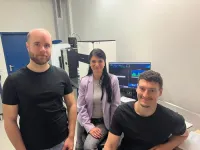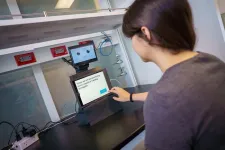(Press-News.org) INDIANAPOLIS – One of the first studies to examine patient acceptability of teleneurology and determine factors influencing acceptability across neurological conditions, has found teleneurology was highly acceptable across the full range of patients with different neurological diagnoses, including headache, movement disorders and other neurological symptoms and diagnoses. The study also determined that the more medical complexity -- having additional diseases -- was associated with increased patient satisfaction with teleneurology.
Older patients were as accepting of teleneurology as younger patients, individuals often viewed as more comfortable with technology. Living in a rural area, typically with inconvenient access to in-person appointments, was also not associated with acceptability of teleneurology.
“There are always going to be certain clinical conditions or patient preferences where in- person visits are essential. But for most patients a large portion of what we're trying to do -- understanding the patients’ symptoms, when they started, what helps them and what makes their symptoms worse -- all those basics that we learn in medical school that we know are at least 75 percent of getting the right diagnosis can be done via video; we can then adapt most parts of our physical exam to be done via video too,” said study senior author Linda S. Williams, M.D., a U.S. Department of Veterans Affairs and Regenstrief Institute research scientist, whose clinical neurology practice focuses on stroke patients. “This is true, no matter the healthcare system.
“Telehealth is more efficient. It may help us make better use of scarce resources when we have physician shortages and, most importantly, it may help us meet patients where they are at home, when they're having trouble or can't drive from perhaps conditions like epilepsy, which are very important in neurology.”
Patients in the study were surveyed two weeks after accessing clinicians via teleneurology. Visits were conducted via video to home or an outpatient primary care clinic with telehealth capabilities.
“Older patients and those with more medical complexity often make up a large portion of the patients requiring care by a neurologist. These findings will help healthcare providers realize they should not exclude consideration of teleneurology for patients that fall into these groups,” said first author Courtney R. Seigel, an Indiana University School of Medicine student.
“There is a tremendous shortage of neurologists in the United States and neurologists, like many specialists, tend to be at a higher density in urban areas and lower density in rural areas,” said Dr. Williams. “Teleneurology is one way that care can be more efficient. We can see many more patients in a given day via telehealth compared to driving to a single remote clinic and so can spread a scarce resource.”
“Patient acceptance of teleneurology across neurologic conditions” is published in the Journal of Neurology. The study was funded by the U.S. Department of Veterans Affairs.
Authors of the study and their affiliations: Courtney R Seigel 1, Holly Martin 2 3, Grace Bastin 2, Laura J. Myers 4 2 3, Stan Taylor 5, Francis Pike 5, Jayne Wilkinson 6 7, Linda S. Williams 2 3 8
1Indiana University School of Medicine, Indianapolis, IN, USA.
2Richard L. Roudebush VAMC HSR&D EXTEND QUERI, Indianapolis, IN, USA.
3Regenstrief Institute, Inc., Indianapolis, IN, USA.
4Indiana University School of Medicine, Indianapolis, IN, USA.
5Department of Biostatistics, Indiana University School of Medicine, Indianapolis, IN, USA.
6Corporal Michael J Crescenz VAMC, Philadelphia, PA, USA.
7Department of Neurology, University of Pennsylvania, Philadelphia, PA, USA.
8Department of Neurology, Indiana University School of Medicine, Indianapolis, IN, USA
Linda S. Williams, M.D.
In addition to her role as a research scientist with the William M. Tierney Center for Health Services Research at Regenstrief Institute, Linda S. Williams, M.D., is a core investigator for the U.S. Department of Veterans Affairs Health Services Research and Development Center for Health Information and Communication and a co-principal investigator for the VA HSR&D Expanding Expertise Through E-health Network Development (EXTEND QUERI) at Richard L. Roudebush VA Medical Center. She also is a professor of neurology at Indiana University School of Medicine.
END
Study examines acceptability of teleneurology across neurological conditions
2024-06-24
ELSE PRESS RELEASES FROM THIS DATE:
Correcting biases in image generator models
2024-06-24
Image generator models – systems that produce new images based on textual descriptions – have become a common and well-known phenomenon in the past year. Their continuous improvement, largely relying on developments in the field of artificial intelligence, makes them an important resource in various fields.
To achieve good results, these models are trained on vast amounts of image-text pairs – for example, matching the text "picture of a dog" to a picture of a dog, repeated millions of times. Through this training, ...
How cells boost gene expression
2024-06-24
The function of non-coding RNA in the cell has long been a mystery to researchers. Unlike coding RNA, non-coding RNA does not produce proteins – yet it exists in large quantities. A research team from the University of Göttingen has now discovered an important function of antisense RNA (asRNA): the researchers found that asRNA acts as a "superhighway" in cell transport and thus accelerates gene expression. The results were published in Nature.
RNA (ribonucleic acid) plays a central role in the translation of DNA information into proteins. There are different types of RNA, one of which is known as messenger ...
Meet CARMEN, a robot that helps people with mild cognitive impairment
2024-06-24
Video: https://youtu.be/bGKA32TlVXM?si=0PdhaUyOKH33DFbB
Meet CARMEN, short for Cognitively Assistive Robot for Motivation and Neurorehabilitation–a small, tabletop robot designed to help people with mild cognitive impairment (MCI) learn skills to improve memory, attention, and executive functioning at home.
Unlike other robots in this space, CARMEN was developed by the research team at the University of California San Diego in collaboration with clinicians, people with MCI, and their care partners. To the best of the researchers’ knowledge, CARMEN is also the only robot that teaches compensatory cognitive strategies to help improve memory and executive function.
“We ...
NYU creates Center for Mind, Ethics, and Policy
2024-06-24
New York University has established the Center for Mind, Ethics, and Policy, which aims to further our understanding of the sentience and moral status of nonhumans, notably animals and AI systems.
“The world contains quintillions of animals, and in the future, it could contain an even larger number of AI systems,” says Jeff Sebo, CMEP’s founding director and a professor in NYU’s Department of Environmental Studies. “Human activity is increasingly shaping the lives of these beings, and these trends raise important and difficult questions, such as: Which of these beings are sentient, ...
New mathematical proof helps to solve equations with random components
2024-06-24
Whether it’s physical phenomena, share prices or climate models – many dynamic processes in our world can be described mathematically with the aid of partial differential equations. Thanks to stochastics – an area of mathematics which deals with probabilities – this is even possible when randomness plays a role in these processes. Something researchers have been working on for some decades now are so-called stochastic partial differential equations. Working together with other researchers, Dr. Markus Tempelmayr ...
Researchers awarded $2.78M federal grant to improve rectal cancer treatment with artificial intelligence
2024-06-24
CLEVELAND—With a new five-year, $2.78 million grant from the National Institutes of Health and National Cancer Institute, researchers at Case Western Reserve University(CWRU), Cleveland Clinic and University Hospitals (UH) will use artificial intelligence (AI) to better treat rectal cancer patients.
The American Cancer Society estimates about 46,000 people nationally will be diagnosed this year with rectal cancer—the third most common type of cancer in the digestive system, after colon and pancreatic cancer.
By using AI, the researchers intend to derive specific metrics on magnetic resonance imaging (MRI) scans to better understand how ...
Manipulating the frequency of terahertz signals through temporal boundaries
2024-06-24
Terahertz technology could help us meet the ever-increasing demand for faster data transfer rates. However, the down-conversion of a terahertz signal to arbitrary lower frequencies is difficult. In a recent study, researchers from Japan have developed a new strategy to up- and down-convert a terahertz signal in a waveguide by dynamically modifying its conductivity using light, creating a temporal boundary. Their findings could pave the way to faster and more efficient optoelectronics and enhanced telecommunications.
As we plunge deeper into the Information Age, the demand for faster data transmission keeps soaring, accentuated by fast progress in fields like deep learning ...
Study links neighborhood violence, lung cancer progression
2024-06-24
CHAMPAIGN, Ill. — Scientists have identified a potential driver of aggressive lung cancer tumors in patients who live in areas with high levels of violent crime. Their study found that stress responses differ between those living in neighborhoods with higher and lower levels of violent crime, and between cancerous and healthy tissues in the same individuals.
The findings are detailed in the journal Cancer Research Communications.
The study was designed to address the higher incidence of lung cancer in Black men than in white men, said University of Illinois Urbana-Champaign ...
Philadelphia social entrepreneurs address root causes of community violence
2024-06-24
PHILADELPHIA, June 24, 2024 — About 80% of an individual’s modifiable health contributors are determined by social and economic factors.[1] Exposure to violence can have detrimental health implications contributing to toxic stress and trauma, mental health illness, substance abuse and an increased risk for heart disease[2].
The American Heart Association, which marked 100 years of service saving lives earlier this month, has distributed $480,000 from the Association’s Bernard J. Tyson Impact Fund to four social ...
Choosing outcomes: new switchable process for synthesizing 3-aminoindolines and 2’-aminoarylacetic acids from same substrate
2024-06-24
Aniline or nitrogen-containing organic molecules like 3-aniline-substituted indoles commonly found in natural products have shown promising results as pharmaceutical contenders. The same goes for moieties such as 2-aminoaryl acetic acid scaffold which forms the fundamental structural motif of nonsteroidal anti-inflammatory drugs such as diclofenac which inhibits COX-2 to relieve pain and inflammation. While there are several ways of synthesizing these molecules individually using different starting materials, can we produce them ...





